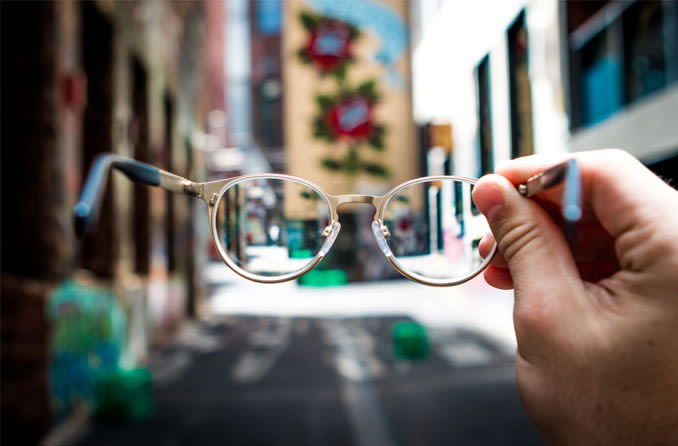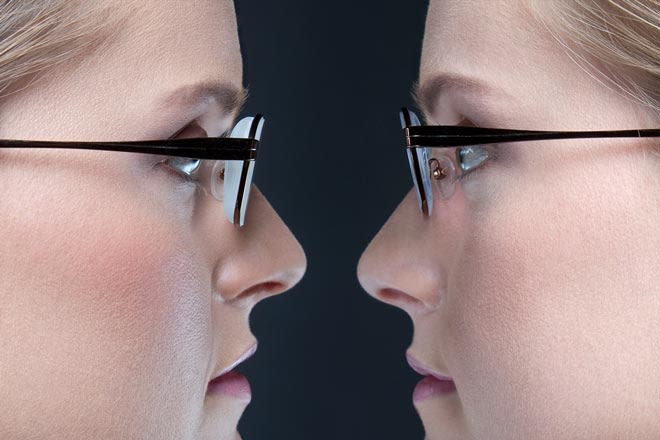High-index vs. regular lenses: What's right for you?

High-index spectacle lenses are the right choice if you want thinner, lighter lenses and glasses that are as attractive and comfortable as possible.
Thinner, lighter high-index lenses are especially recommended if you have a strong prescription but high-index lenses can make your spectacles noticeably slimmer, lighter and more attractive regardless of how strong your prescription is.
Many spectacle wearers are short-sighted, which requires lenses that are thin in the centre but thicker at the edge. The stronger the prescription, the thicker the edges.
Today's fashionable frames are made of plastic or metal with rims that are often thinner than the lens itself.
Also, popular rimless styles mean that the edges of the lenses are completely exposed.
In either case, the lens edges are highly visible, and thicker edges can detract from the appearance of your eye-wear.
High-index lenses vs. regular spectacle lenses
Spectacle lenses correct refractive errors by bending (refracting) light as it passes through the lens. The amount of light-bending ability (lens power) that's needed to provide good vision is indicated on the spectacle prescription provided by your optometrist.

The difference a high-index lens material can make: the same correction for nearsightedness in regular plastic lenses (left) vs. high-index lenses (right). Images: Essilor
Refractive errors and lens powers required to correct them are measured in units called dioptres (D). If you are mildly short-sighted (myopic), your lens prescription might say -2.00 D. If you are highly myopic, it might say -8.00 D.
If you are long-sighted (hyperopic), you need "plus" (+) lenses, which are thicker in the centre and thinner at the edge.
Regular plastic lenses for high amounts of myopia or hyperopia can be quite thick and heavy.
Fortunately, manufacturers have created a variety of new "high-index" plastic lens materials that refract light more efficiently.
This means less material is used in high-index lenses to correct the same amount of refractive error, which makes high-index plastic lenses both thinner and lighter than conventional plastic lenses.
Advantages of high-index lenses
Thinner
With their ability to refract light more efficiently, high-index lenses for myopes have thinner edges than lenses with the same prescription power that are made of conventional plastic material.
Lighter
Thinner edges require less lens material, which reduces the overall weight of the lenses. Lenses made of high-index plastic are often lighter than the same lenses made in conventional plastic, so they're more comfortable to wear.
Lightweight lenses are more of a benefit for long sighted prescriptions, which can be heavy when made in conventional lenses.
In addition, most high-index lenses also have an aspheric design, which gives them a flatter, more attractive profile and reduces the magnification of the wearer's face that conventional lenses cause in strong long-sighted prescriptions.
High-index lens choices
There is a wide variety of thin, lightweight high-index spectacle lenses.
The refracting ability of spectacle lenses is determined by the "refractive index" of the lens material. This refractive index is the ratio of the speed of light when it travels through air compared to the speed of light when it passes through the lens material.
The more the speed of light is reduced, the more it is refracted as it passes through a material. So lenses that refract light more efficiently have a higher refractive index and lenses with a higher refractive index are thinner than lenses of the same power made of materials of a lower refractive index.
In short: the higher the refractive index, the thinner the lens.
Conventional plastic lenses have a refractive index of approximately 1.50.
Any lens material with a refractive index that's higher than that of ordinary plastic is considered to be high-index.
High-index plastic lenses are now available from 1.53 to 1.74. Lenses with a refractive index of 1.70 or higher typically are at least 50 percent thinner than conventional plastic lenses.
Also, generally speaking, higher index, means an increase in the cost of the lenses but relative to other things we spend money on everyday e.g. a cup of coffee can be $4.50, attractive glasses usually cost less per day over the life of the prescription. Remember to that your glasses are on your face every waking hour so you want to look your best.
Your spectacle prescription is only one factor that determines what kind of high-index material you might want for your lens. The highest index materials are often used for stronger prescriptions but if you play sport or want fashionable wrap around sunnies, polycarbonate lenses may better suit your needs. 1.67 index material works well in rimless frames and so on.
If you want high-index lenses, be sure to ask for them and rely on your optometrist's advice regarding which index to use. Your optometrist can explain which high-index lenses are the best choice for your needs.
Most of today's popular lens designs and features — including progressive lenses and photochromic lenses — are available in high-index materials but there are exceptions, so ask your optometrist for details.
AR coating: A perfect companion for high-index lenses
All lens materials block some light from passing through the lens. This light reflects back from the lens surface, causing distractions, ghost images and reducing the clarity of night vision.
Conventional plastic lenses reflect about 8 percent of light that would otherwise enter the eye. High-index lenses reflect up to 18 percent meaning they really need an anti-reflection coating to be truly efficient.
For the best vision and appearance, it's a good idea to have an anti-reflection lens coating (AR coating) applied to high-index lenses. AR-coated high-index lenses transmit up to 99.5 percent of light to the eye for optimum vision.
As AR coating virtually eliminates lens reflections, it makes high-index lenses appear nearly invisible, so others see your eyes, not your lenses.
Studies have shown that spectacle lenses with anti-reflection coatings provide sharper night vision with less ghosting — a real advantage for night drivers.
Page published on Tuesday, 17 March 2020






